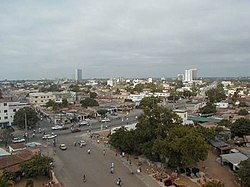capital of Togo From Wikipedia, the free encyclopedia
Lomé is the capital city of Togo. Lomé is the administrative and industrial center of the country. The city is also the main port of Togo. The city exports coffee, cocoa, copra, and palm kernels. The population of the city was estimated as around 700,000 people in 1998. It is estimated that more than 1 million people live in Lomé area at that time.[2]
Lomé | |
|---|---|
City | |
 A view of Lomé | |
| Coordinates: 6°7′55″N 1°13′22″E | |
| Country | |
| Region | Maritime Region |
| Prefecture | Golfe |
| Government | |
| • Mayor | Aouissi Lodé |
| Area | |
| • City | 99.14 km2 (38.28 sq mi) |
| • Metro | 280 km2 (110 sq mi) |
| Elevation | 10 m (30 ft) |
| Population (2010 census) | |
| • City | 837,437 |
| • Density | 9,305/km2 (24,100/sq mi) |
| • Metro | 1,477,660 |
| • Metro density | 5,608/km2 (14,520/sq mi) |
| Time zone | UTC |
| HDI (2017) | 0.593[1] medium · 1st |
Lomé is on the Gulf of Guinea. It is in the south west of Togo, on the border between Togo and Ghana. Things to see in the city include Lomé Grand Market, the Togo National Museum in the Palais de Congrés, a fetish (voodoo) market, Lomé Cathedral, beaches and the former wharf.
The city was founded in the eighteenth century by the Ewe people. In 1882, the village, known then as Bey Beach, became a major trading center for the British.
Bey Beach became the capital of Togo when the German rulers moved the capital from Aneho in 1897. The city then grew quickly until it was taken by the French Army in 1914 during World War I.
Seamless Wikipedia browsing. On steroids.
Every time you click a link to Wikipedia, Wiktionary or Wikiquote in your browser's search results, it will show the modern Wikiwand interface.
Wikiwand extension is a five stars, simple, with minimum permission required to keep your browsing private, safe and transparent.